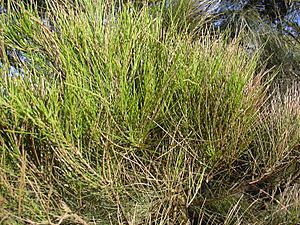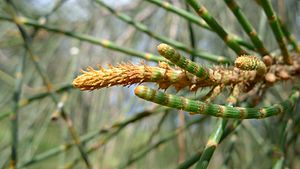Swamp she-oak facts for kids
Quick facts for kids Swamp she-oak |
|
|---|---|
 |
|
| Scientific classification | |
| Genus: |
Casuarina
|
| Species: |
glauca
|
The Casuarina glauca, also known as the swamp she-oak or swamp oak, is a special type of tree. It grows naturally along the east coast of Australia. You can find it from central Queensland down to southern New South Wales. This tree has also spread to the Everglades in Florida, where it is now considered a plant that grows too much.
Contents
About the Swamp Oak's Name
The swamp oak was first described in 1826 by a person named Franz Sieber. He gave it the scientific name Casuarina glauca. The word glauca comes from Latin and means "glaucous," which describes a dull, grayish-green color.
Indigenous people have their own names for this plant. The Kabi people call it bilai. This name was even used for a town in Queensland called Bli Bli, Queensland. The Gadigal people call it guman.
What the Swamp Oak Looks Like
The swamp oak is a medium-sized tree. It usually grows between 8 and 20 meters (about 26 to 65 feet) tall. Sometimes, it can grow even taller than 30 meters (nearly 100 feet)! However, if it grows on windy clifftops, it might stay as a small shrub, only about 2 meters (7 feet) tall.
The bark of the tree is grayish-brown. It has small scales and tiny cracks. The branches have many long, drooping parts that look like thin green strings. These parts can be up to 38 centimeters (15 inches) long. They are made of small, tube-shaped sections called articles. Each article is about 8 to 20 millimeters long.
The actual leaves of the tree are very tiny. They look like small brown "teeth" and are only about 0.6 to 0.9 millimeters long. You can find 12 to 17 of these tiny teeth at the joints between the articles on the branchlets. The tree also produces oval-shaped cones, which are about 9 to 18 millimeters long.
Where the Swamp Oak Lives
Casuarina glauca grows along the eastern coast of Australia. It stretches from Yeppoon in central Queensland all the way down to Bermagui in southern New South Wales. Some of these trees in the Royal Botanic Gardens in Sydney were there even before Europeans arrived in Australia.
Sadly, some swamp oak populations along the New South Wales coast are at risk. This is because their natural homes are being cleared for new buildings. As mentioned, this tree has also become a big problem in Florida because it spreads very quickly there.
This tree likes to grow in or near salty water. You can often find it along riverbanks and in areas where rivers meet the sea. The swamp oak can grow from its roots, forming thick groups of trees. It grows well in rich, muddy soils that come from sandstone or shale. It prefers places where the water level is close to the surface, usually 30 centimeters (about 1 foot) or less. The tree helps turn shallow water into land by stopping soil from washing away and by collecting dirt among its roots.
How the Swamp Oak Lives and Grows
The swamp oak is special because it helps put nitrogen into the soil. It has small bumps on its roots called nodules. These nodules contain tiny living things that help the tree get nitrogen from the air. Nitrogen is like food for plants, helping them grow strong.
Other living things also interact with the swamp oak. The rat's tail orchid (Dendrobium teretifolium) can grow on the swamp oak tree. The young stages (larvae) of the she-oak moth (Pernattia pusilla) eat parts of the C. glauca tree.
Swamp oak trees can live for a very long time, sometimes 100 to 200 years! After a bushfire, these trees can grow back from their roots. If a tree is cut down, new shoots can grow strongly from the stump, creating new groups of trees.
The swamp oak drops a lot of old cones and branchlets. This material eventually breaks down and makes the soil richer. However, if there's a flood, this material might be washed away.
Many smaller plants grow under swamp oak trees. These include plants like Juncus kraussii, Baumea juncea, and Sporobolus virginicus in sandy soils. In clay soils, you might find plants like Apium prostratum, Carex appressa, Goodenia ovata, and Phragmites australis. A climbing plant called Parsonsia straminea also grows there.
Birds love the swamp oak! Glossy black cockatoos break open the cones to eat the seeds, which are ready in winter. The seeds are also a food source for the red-browed finch and the peaceful dove (Geopelia placida).
Uses and Growing the Swamp Oak
Casuarina glauca has been planted widely in cities like Canberra as a street tree. It was also brought to Haiti to help stabilize the soil and to provide wood for poles. In Florida, it was planted as a beautiful garden plant and to block wind.
People have even used the bark of the swamp oak as a place to grow orchids.
This tree can handle wet soils and even soils that are a bit salty. However, in cities, its roots can be a problem. They can grow into underground water and sewer pipes if the tree is too close, sometimes within 15 meters (50 feet). It can also make some soils more acidic by lowering the water level.
There are two types of swamp oak that grow low to the ground. These are called 'Cousin It' and 'Kattang Karpet'. 'Cousin It' was found in Booderee National Park in 1989. It was named because it looks like the character Cousin Itt from a famous TV show. 'Kattang Karpet' was found in Kattang Nature Reserve in 1998.
Images for kids
See also
 In Spanish: Casuarina glauca para niños
In Spanish: Casuarina glauca para niños



